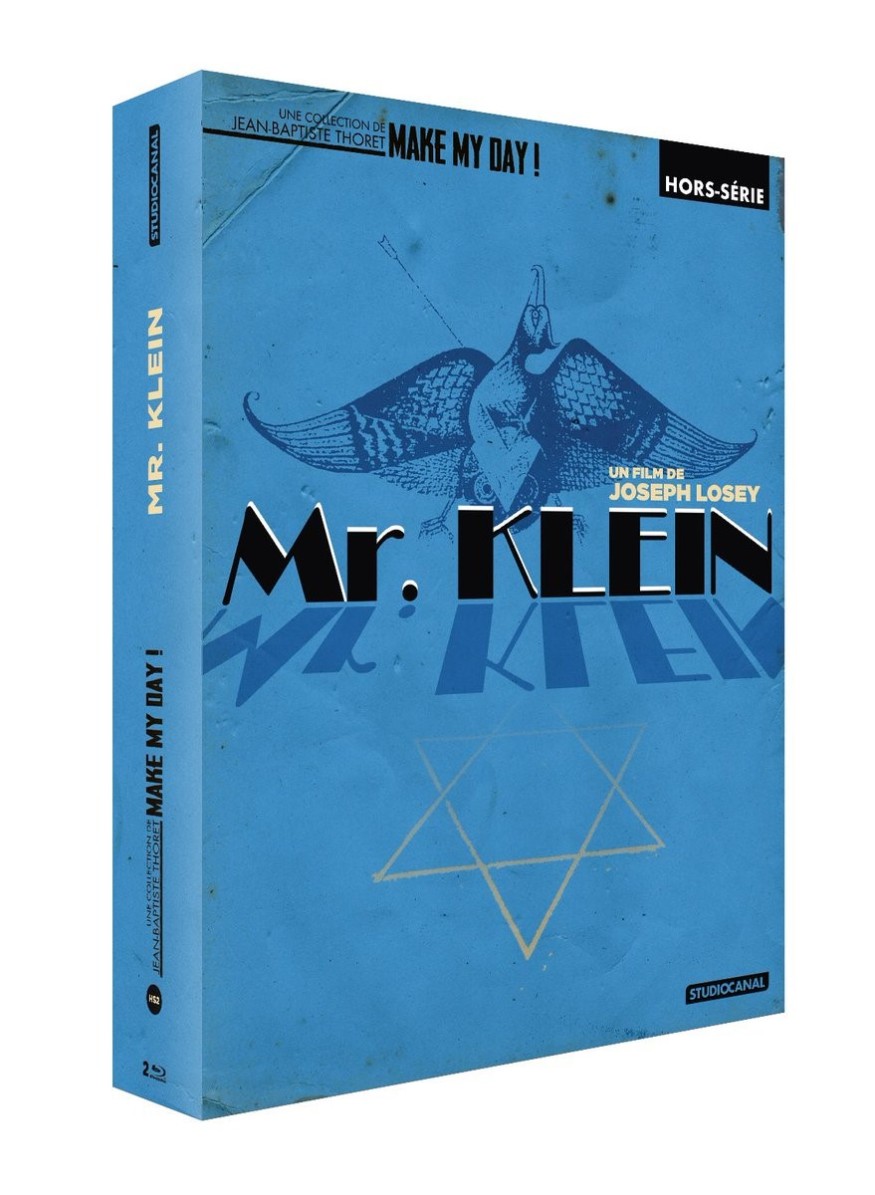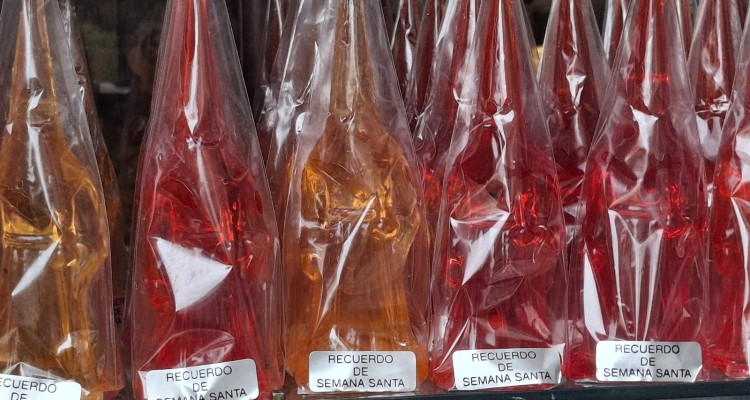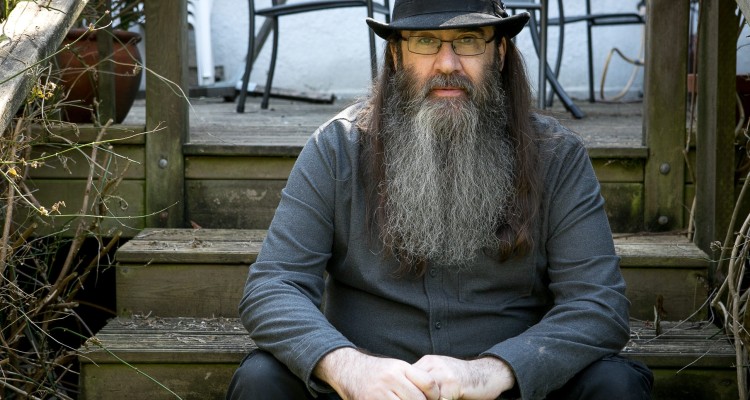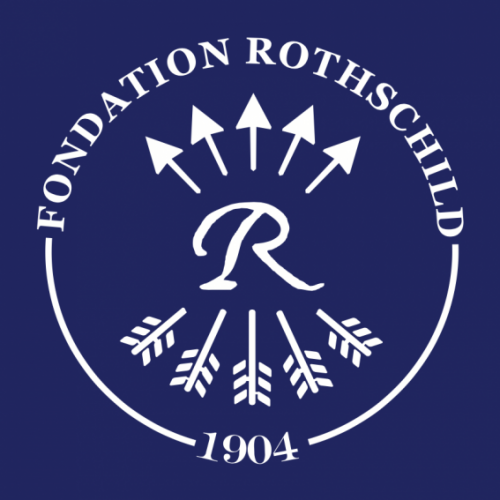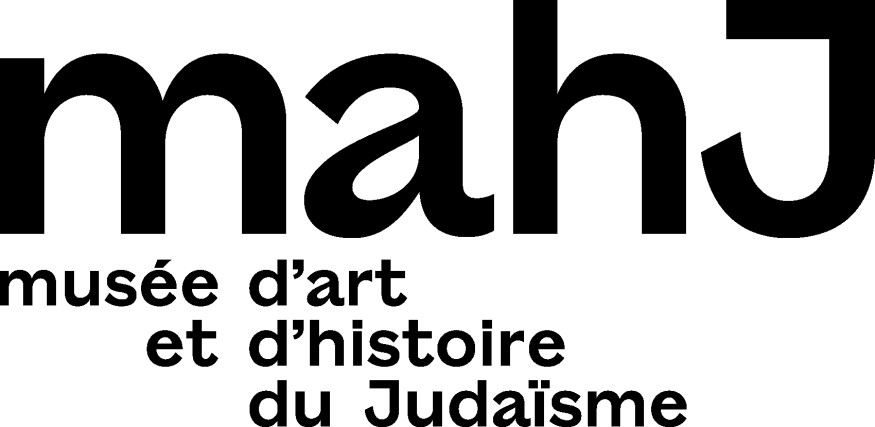July 1942. Robert Klein is a Parisian art dealer who takes advantage of the Occupation to enrich himself on the backs of Jews forced to sell the pieces of art they own at low prices. One day, he receives a copy of “Information Juive” in his name. But isn’t Klein a good French Catholic? Who is this double? Is it a misunderstanding? A manipulation? Klein goes in search of this Other… and thereby of himself. Jean-Baptiste Thoret revisits Joseph Losey’s film on the occasion of its release on Blu-ray, with numerous bonus features and an edited volume commenting this masterpiece made in 1976.
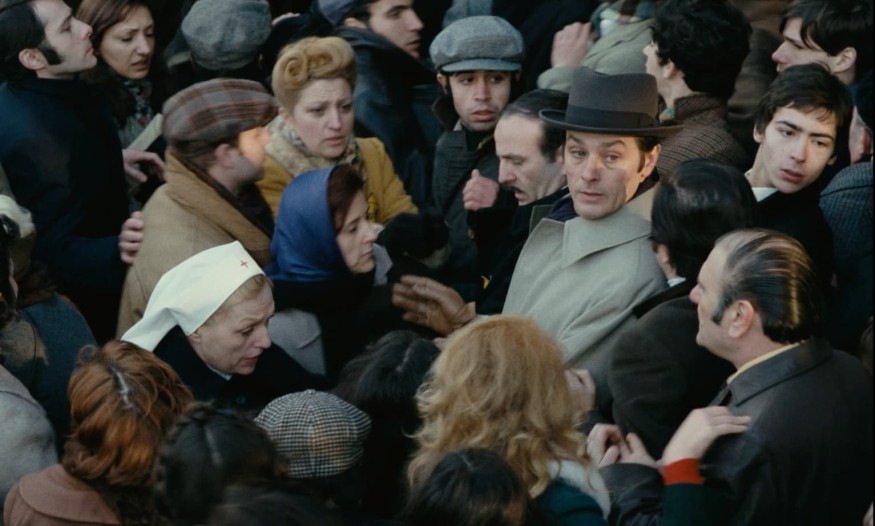
In the first part of the French film Mr. Klein, two narratives progress in parallel, but deaf to each other, like two Frances that, in 1942, watched one another as if separated by a chasm, or even ignored each other completely – the meticulous preparation of the round-up, the police investigation and the construction of the velodrome on the one hand, and on the other, the life of the Parisian bourgeoisie of which Klein is an exemplary representative. Franco Solinas, the film’s screenwriter, and Joseph Losey converted this French schizophrenia into an identity problem, via the two Robert Kleins in the 1976 film: the first is a model citizen belonging to an elite that accommodates collaboration and the laws it produces, and even uses the Nazi presence to pour out its anti-Semitic bile (the cabaret sequence), while the second is an invisible man who undoubtedly stands with the opposite camp, where Resistance fighters, political activists, and Jews eager to evade a French administration that produces records on them, despoils them, and soon hunts them down. This indifference of one France toward the other is signified very early on in the film, by the connection of two shots that respond to each other in a scandalous contrast: first, the mouth of this Jewish woman, manipulated in a close-up by an epigone of the race scientist and ‘doctor’ George Montandon during the opening sequence, and then, just afterward, the made-up lips of Jeannine, Robert Klein’s languid mistress, captured in the vanity mirror of a bourgeois room where she is killing time. In the exchange that follows between Klein the art dealer and a Jew (Jean Bouise) who is forced to sell an old family painting for a small sum of money, Losey further emphasizes the insensitivity of one part of the population toward the other, like a poison destined to spread throughout history. In the end, Klein sees his interlocutor but does not look at him – unlike Van Ostade’s painting, which he scrutinizes for a long time – just as the doctor from the Vichy regime’s Commission on Jewish Questions proceeds, in all impassivity, to what was then called an “anthropometric examination,” and searches the body of a terrified woman for anatomical signs which would prove her Jewishness.
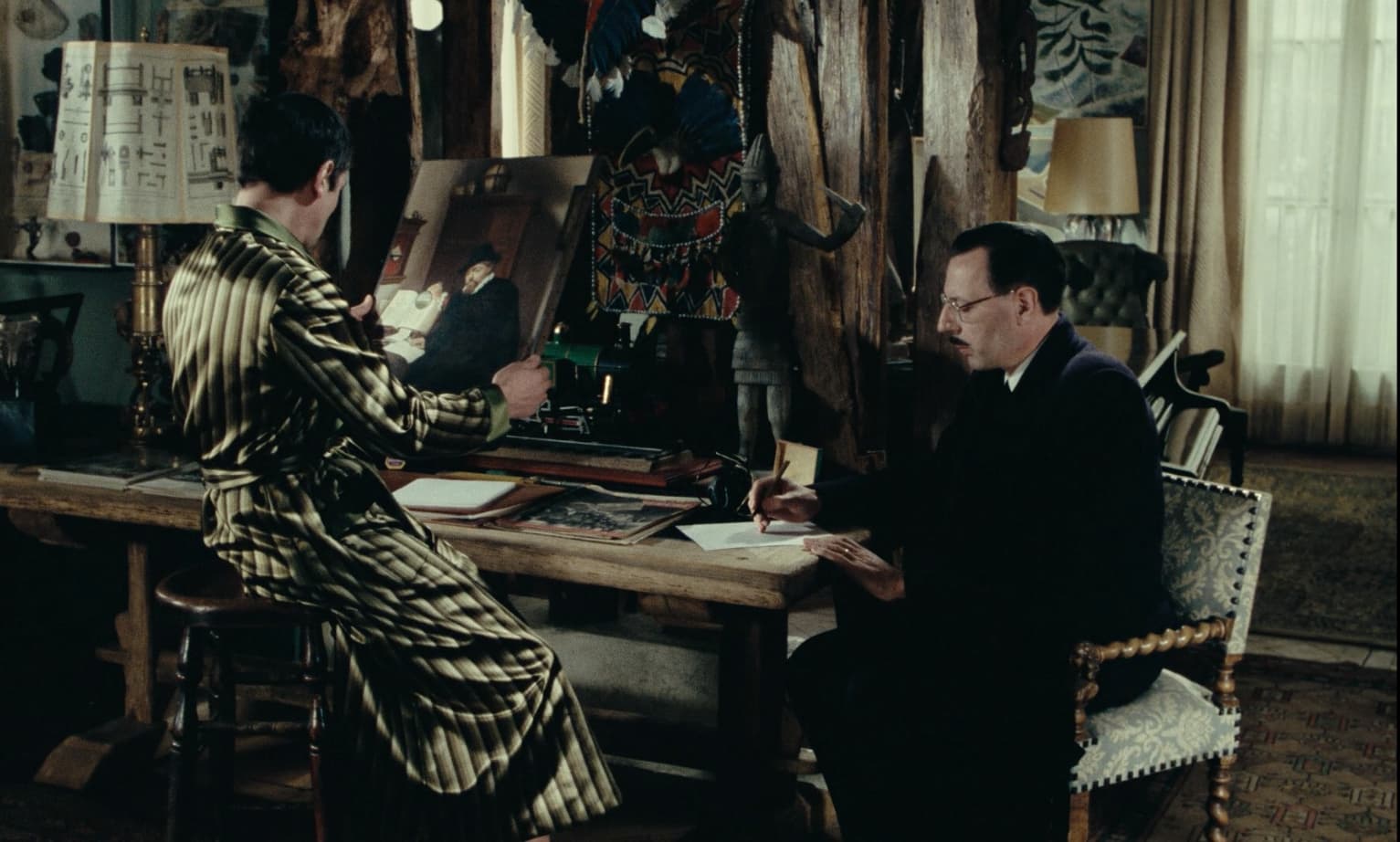
A few minutes later, a black screen juxtaposes two realities that can be seen without looking at each other: a shot of Klein at a window and its counter-shot of scaffolding and workers carrying boards and hammering nails. Losey insists a lot on the material construction of the place that, in the film, will serve as the Velodrome d’Hiver, the notorious site where thousands of Jews were confined in Paris before being shipped off to their death. But in the France of 1976, the images that punctuate the narrative also metaphorize the need to (re)construct a memory of the occupation after the revelations of Raoul Levy and Robert Paxton, who did much to puncture France’s post-war self-concept as ‘the nation of 40 million resisters.’ At the end of the film, Losey repeats this motif of the counter-shot when, rounded up and thrown onto a bus among other Jews, Klein scribbles something on a piece of paper (no doubt a note to Pierre, his lawyer) which he throws out the window to the attention of a salesman in the hope that he will pick it up. This time, Klein is on the side of the scaffolding, in other words, on the Jewish side of history: the bus starts up again, Klein’s eyes follow the young man, who passively stares at the piece of paper that has fallen on the pavement. The salesman raises his head and fixes his eyes in Klein’s, but it is an empty, inert look. The sequence thus ends in suspense on an action that is desired but does not take place, on an impossible interlocution that shows, at the very moment when the raid takes place, the impermeability between the two stories that are being played out here.
The Truth
During the Vel d’Hiv roundup, in which 13,000 Jews were arrested by the Vichy police in 1942, 5,000 were sent to the Drancy camp and 8,000 to the velodrome, where the heat was oppressive under the immense glass roof above. It was not until July 19, 1942 that the Velodrome was evacuated. The families were taken to the camps of Pithiviers and Beaune-la-Rolande, in the Loiret, while the adults were deported to Drancy, a stop on their path to death in the concentration camps of the east. In the final sequence of Mr. Klein, Losey brings together in one imaginary place these different operations: Klein’s arrival at the Velodrome, the distribution of the rounded-up in alphabetical order, and then the beginning of the deportation by trains parked behind the bleachers. In the original film script, the words “Auschwitz” were even drawn in chalk on the train car into which Klein was rushed, a chilling shortcut to a journey of no return. By ringing the stadium with barbed wire and watchtowers, by moving the round-up from summer to winter 1942, Losey twists the historical reality and conceives a fictional place that combines the Velodrome with the attributes of the detention and concentration camps, a way of signifying how the hundreds of kilometers that separated one from the other did not exist, since the Velodrome was the antechamber of a certain deportation and tragic end. In 1942, to be a Jew in Paris, in other words in the occupied zone, was to be taken to and murdered in a German camp.
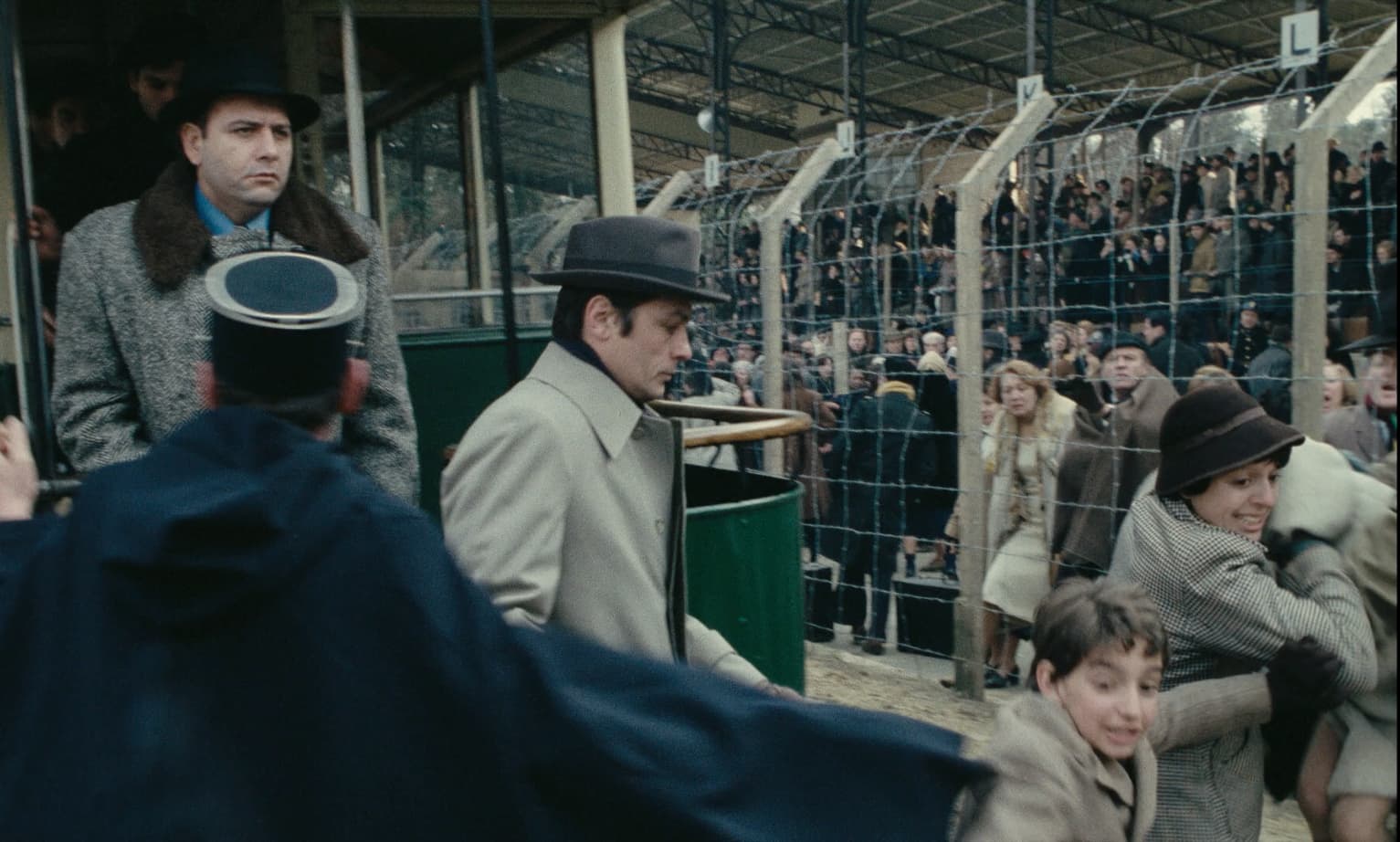
In reality, German trains were not waiting for Jews near the Velodrome, just as Nazi soldiers, who appeared next to the cars, only took over from the French police at the border between France and Germany. However, all the Jews piled up in the Velodrome were deported to Auschwitz. Against historical accuracy but in the name of the truth of history, Losey chooses to show the Nazi soldiers on the train platform, as if he were deliberately confusing the beginning and the end of this police operation. By reducing to nothing the spatio-temporal distance that separated the Vel d’Hiv from the death camps, Losey displays as much a retrospective bias – in 1976, the truth was largely established but the wound was still alive – as a desire to film against those who, in 1942, who claimed to be unaware of the fate to which these Frenchmen, rounded up because of their Jewishness, were destined, but also against those who, years later, would defend the thesis of the shield (Pétain) and the sword (De Gaulle), according to which the collaborationist policy of Vichy had made it possible to save most French Jews.
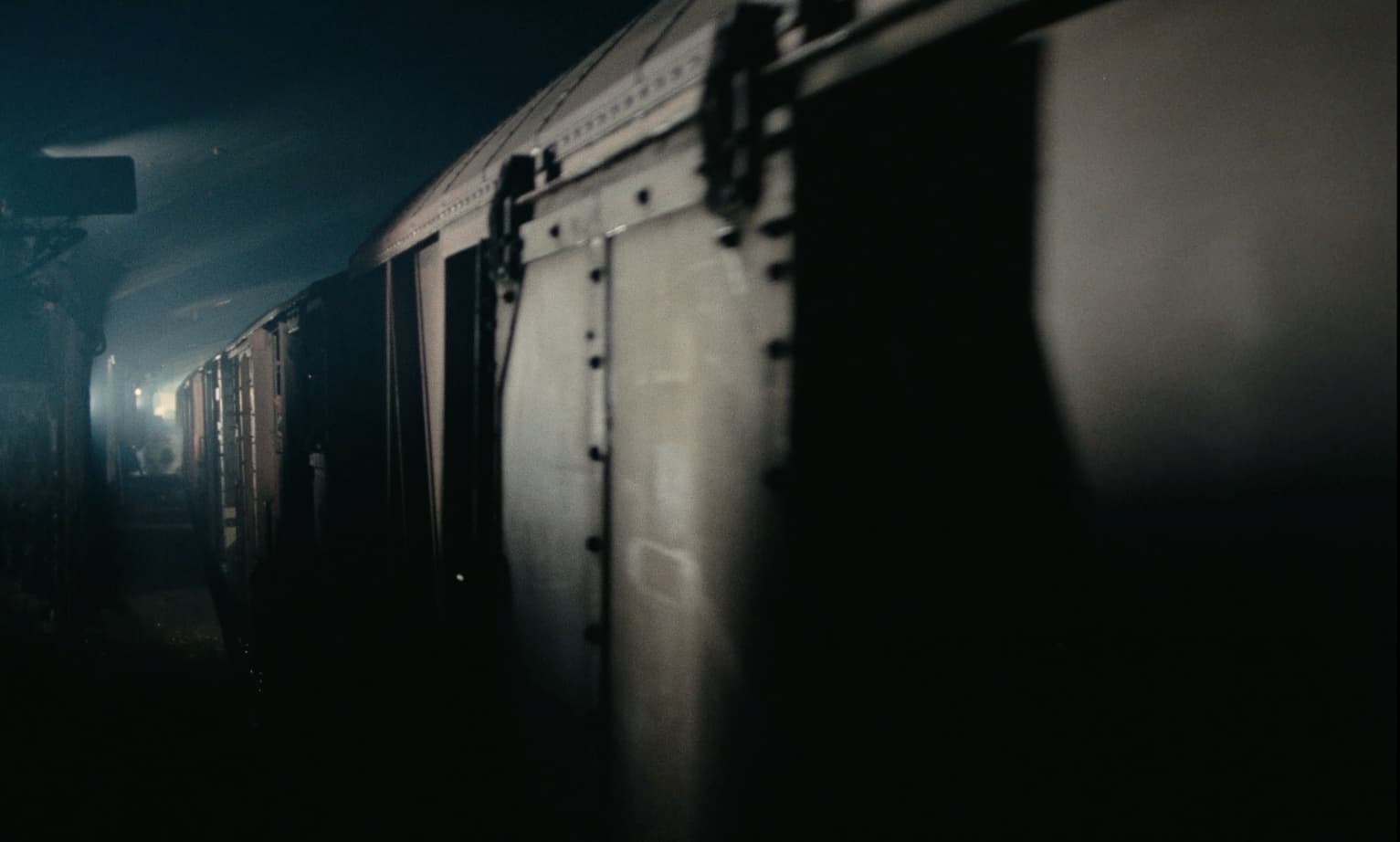
From One Sign to Another
From the very beginning of the film – a fresco showing a bird of prey pierced by an arrow and overflown by a vulture spreading its threatening wings – Mr. Klein announces itself as a cryptic film which, from beginning to end, multiplies symbols, allegories, allusions to the Kabbalah, literary references (Melville and his Moby Dick), strange rhymes and correspondences to be detected. Mr. Klein supposes, in fact, a spectator on the lookout, an investigator-spectator, concentrated on all the corners of the image, mobilized on the slightest detail, quick to spot here a motif already seen (a spiral pattern on a boot) and there the traces of dust left by paintings that are missing from their place (the bare walls of the corridors of the castle of Ivry-La Bataille which suggest that it belongs to a family of well-to-do Jews preparing for exile). The hermeneutic fever that any attentive viewer of the film contracts comes in part from its asserted filiation with North by Northwest, the Hitchcockian summit of the interpretive art that nourished Solinas’ writing, and undoubtedly participated in the ever-renewed fascination that each of his visions provides. What is profoundly Hitchcockian in Mr. Klein is the way in which the images only make sense once they are put in relation to each other. Each sign necessarily calls for another, often its twin, with which it must be paired. Images, faces, attitudes must be constantly compared and conbined. This attention to the smallest sign, of which the film is full, contaminates the whole story, starting with the characters’ view of others and the reality that surrounds them, as if the inquisitive Zeitgeist of the time was poisoning all relationships, both human and visual. For the hunted, it is a matter of concealing everything that, on the outside, would reveal what they are inside; for the hunters, testing the a priori guilt of the visible, of all behaviors, of all faces and of the slightest image. In his interviews with Michel Ciment, Joseph Losey insists on the importance of the opening sequence of Mr. Klein – this naked woman groped like an animal by a repulsive doctor who has to rule on her belonging to the “Semitic race” on behalf of the Commission on Jewish Questions – but above all on its placement at the beginning of the film, decided on, according to him, at the end of several prevarications with Franco Solinas, the scriptwriter. Without this sequence, Losey says, the film loses its raison d’être and its backbone, it literally falls apart, as if this sequence expressed a way of manipulating the visible that would affect the whole film.
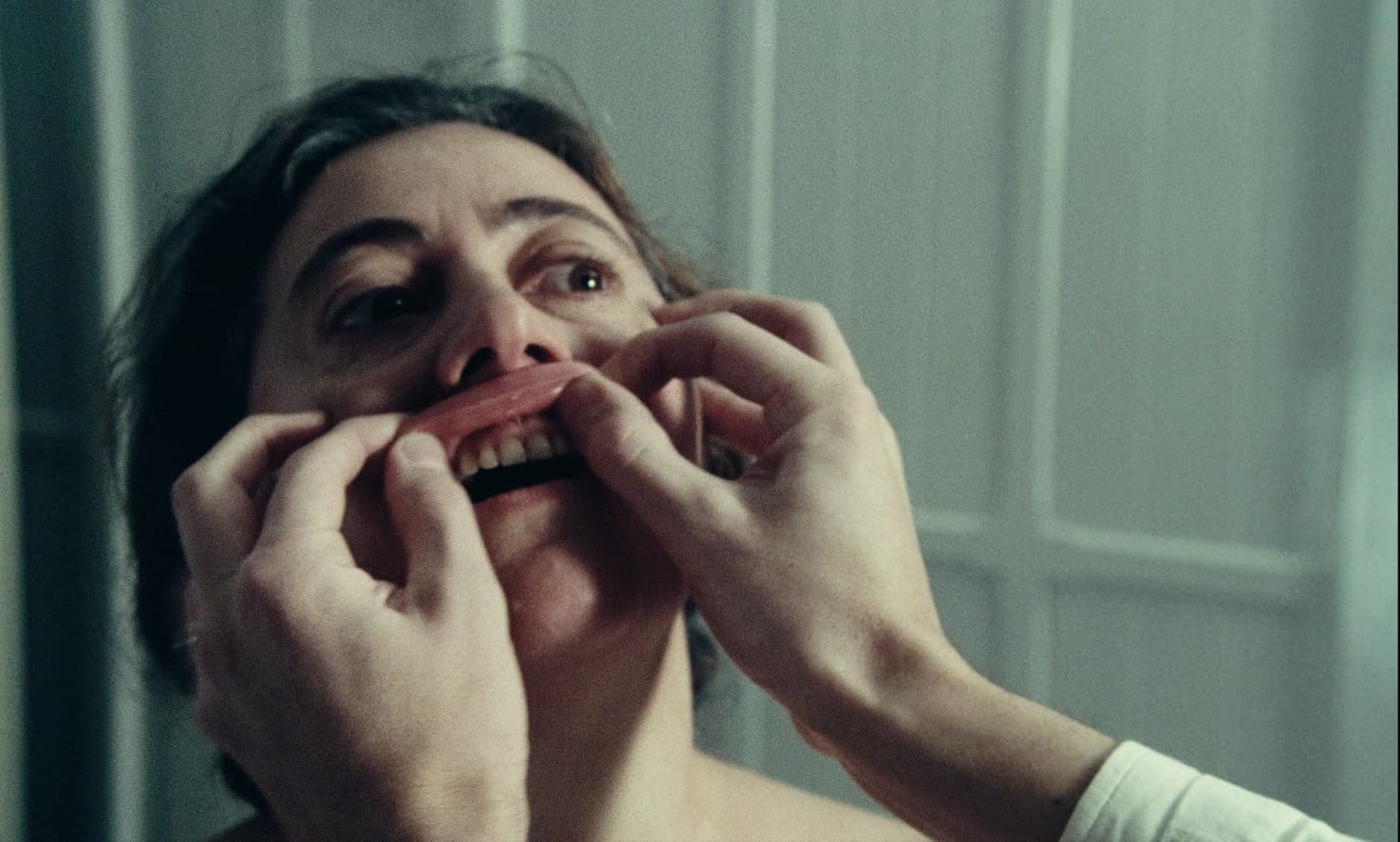
In Mr. Klein, a single word, a look or a simple impression of resemblance (the doorman who, for a moment, confuses Klein 1 with his tenant Klein 2) is enough for an individual to fall on the wrong side of history. The images themselves do not escape this trade based on the postulate of a necessary suspicion. There is a lot of talk about photos in the film, from the Balard factory worker (one face but several identities) that Klein wants to find, to the shot of his namesake, on a motorcycle and in the company of a woman, that he has developed in a dark-room. But Losey frames the photo from a distance, preventing us from confronting the faces of the two men – but did Klein see something we did not? Thus, the analysis of these photos always proves disappointing, since each one of them refers to an infinite number of readings (the worker and his multiple first names) that revives the hermeneutic machine more than it attenuates it. In the end, images, like identities, are volatile and possess the meaning that one wishes to give them. For Losey and Solinas have conceived the story of Mr. Klein on the principle of the Russian doll, but inverted, since each sequence of the film, like each photograph, resolves something of the previous one at the same time as it opens a little more the field of possibilities. The signs to be interpreted take turns, proliferate, always anticipating the mind of the spectator who finds himself, like Klein 1 (our protagonist), groping his way through the film, always slightly behind the event to come.
The theme of the double, which haunts all of Mr. Klein‘s narrative, has the primary effect of disturbing, even atomizing the innocence of the images, their literal meaning, since what we see is not necessarily what is. It is not only Robert Klein who is on the run toward his homonym, the supposed Klein 2, whose fate has become his due to mistaken identity, but it is the whole film that is threatened by its double, its repressed and its specters: repressed identity (Klein’s Jewishness?), the historical repressed (this Occupation that suddenly finds someone who was downplaying it) and the existential repressed (what if Klein wanted to become someone else?). In fact, each sequence in the film moves the narrative toward a full and desired denouement (does Klein 2 exist? Is Klein 1 Jewish? Will he escape the roundup?), at the same time as it moves it (us) back towards an original question on which it is based. The more we progress in the film, the more the chasm of interpretations deepens. Mr. Klein is thus, to use the title of a famous short story by Borges, a film with paths that fork off off, indefinitely. This original question is at the same time a family novel, an existential quest and the search for an identity which, in essence, cannot be found.
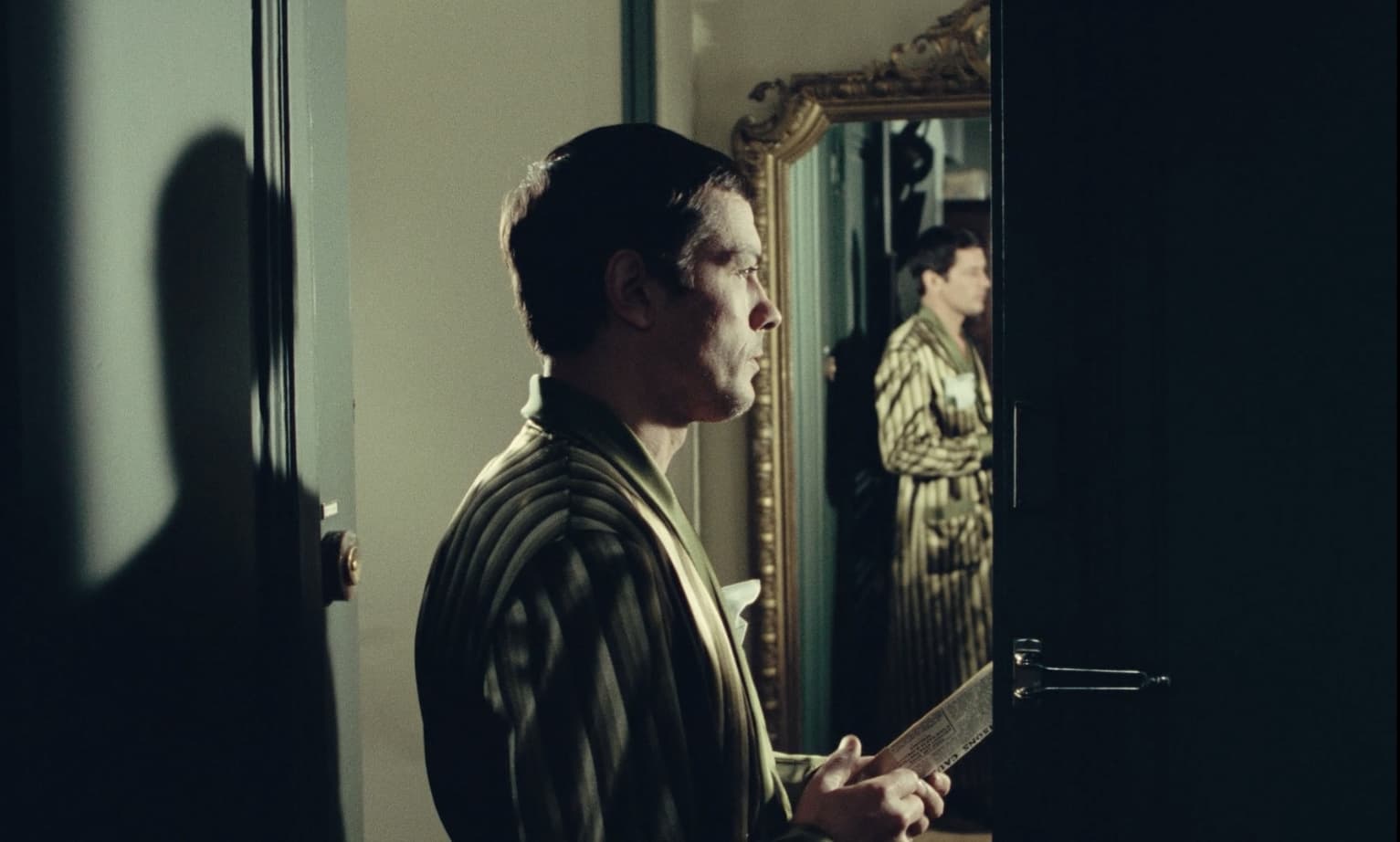
Basically, all identity, Klein tells us, is a doubtful case. In the first part, Klein struggles to find proof that he is a non-Jew, but little by little, the boundary between him and the other teeters, falters, even flirts with the territories of the fantastic and the absurd. Not only does the film’s script construct a forced identification between Klein and his Jewish namesake with a lot of concordant clues (same silhouette, same readings…), but it even goes so far as to imagine a scene that escapes all narrative logic. One morning, Klein, already Aryanized (expropriated) and reclusive in his empty apartment, leaves his house and buys a newspaper at the newsstand on his street. A German shepherd – the same one seen in the photo in Klein 2 – is roaming around and ends up following Klein to the door of his apartment building. At first reluctant, Klein agrees to let him in. This stray dog, whose name no one knows and to whom Klein will become attached, obviously belongs to his namesake, and functions as an element that has passed from one world to another. From a Cartesian point of view, there is nothing to explain why the animal recognizes a man he does not know, but from a symbolic point of view, he passes from the same (Klein 2) to the same (Klein 1), as if the scenario introduced here the proof of a metamorphosis in progress.
The Untraceable Identity
Klein 1 is the body through which Losey organizes the movement between the two Frances of 1942, since Klein 1’s investigation leads him to seek out his namesake, Klein 2, in the opposite territory, to become aware of his conditions of existence and the rules that organize them, which are a thousand miles away from those to which his own are subject. The two films run side by side and, under the impetus of Robert Klein himself, end up being tied together when the police burst into his apartment to seize his belongings, in the name of laws that, in his world, have no place. In Vichy France, Klein 1, the good Catholic, has become Klein 2, a presumed Jew, hunted down by dint of having fabricated with the authorities the conditions for the possibility of a doubt about his civil identity that has finally caught up with him. In Vichy France, however, doubt was in fact a charge, and for some it was a certainty, since those designated as guilty had to prove their “innocence” themselves, in other words the purity of their lineage. “I don’t question the law, but it doesn’t concern me,” Klein naively asserts to the police commissioner, without understanding that in the latter’s eyes, he no longer occupies the position of the privileged person who could brazenly avert his eyes from the horrors of Aryanization, but that he now belongs, under the Occupation, to the territory of the banished.
From this point of view, Mr. Klein is a profoundly Sartrean film, since the individual suddenly finds himself dislodged from himself by an Other (the Vichy administrative steamroller…) who assigns him an identity whose contours he himself has fixed. This other duplicates the individual that he envisages since it makes emerge in him an Other that he does not recognize. Or that he did not know. Thus, Klein 1 will be Jewish and treated as such until he proves the contrary. The first part of the film is built on this frantic quest of Klein 1 to pursue his namesake, Klein 2, so that he can exonerate him from being what Vichy says he is. This is the Kafkaesque moment of his adventure.
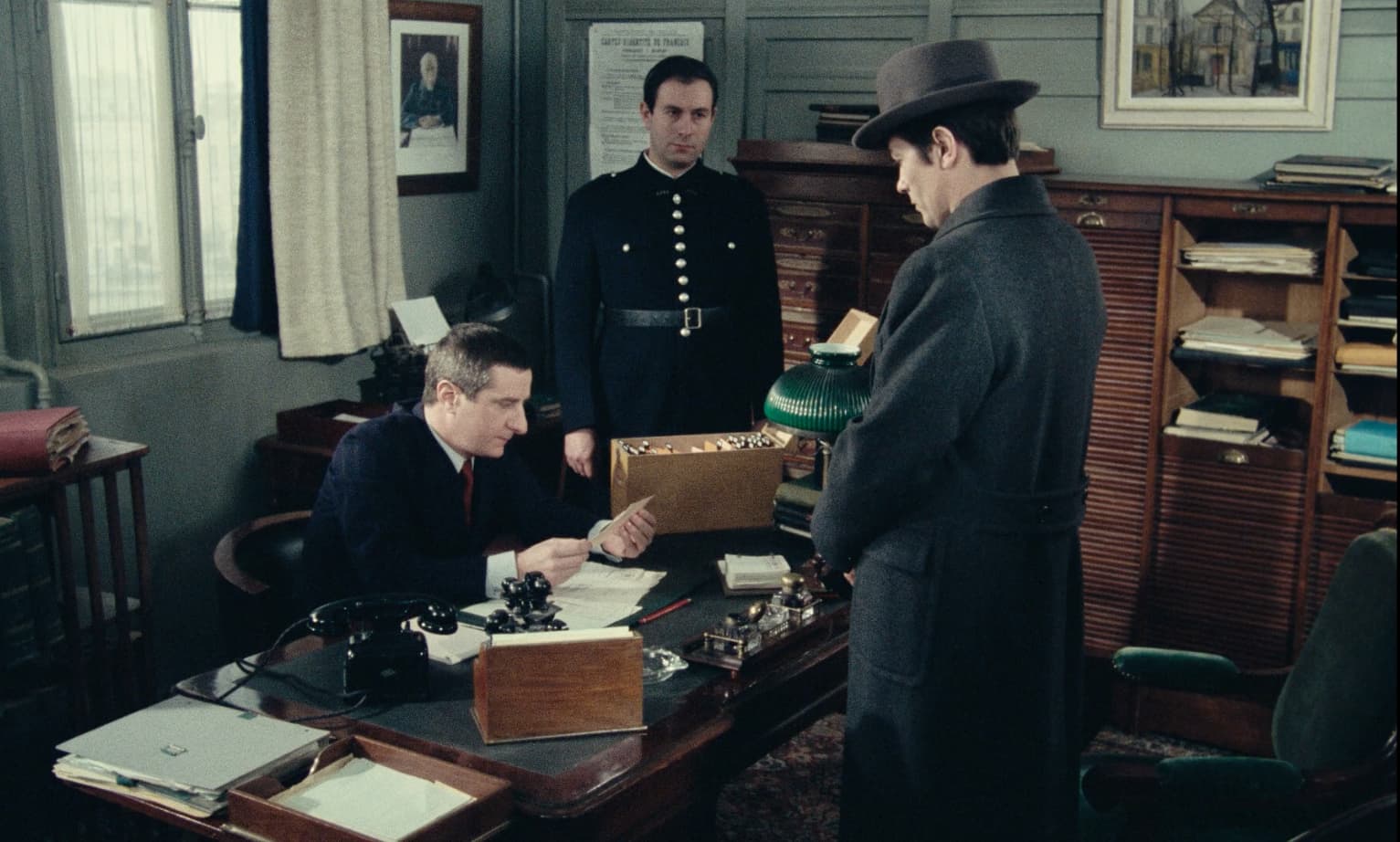
Just after finding a copy of Informations Juives (a Jewish periodical produced under the Occupation) left by a stranger on his doormat, Klein contemplates himself in a mirror located in front of his front door, and this gesture, which consists of looking at his reflection, will be repeated several times in the film (in the sequence of the Cupola, in front of Klein 2’s bathroom mirror…), as if it were a matter of externalizing this other, of materializing it in front of oneself and organizing a silent encounter with it. From that moment on, the man plunges into a double field, on the one hand the field of the family and administrative narrative (delving into the genealogy of a “Catholic family since Louis XIV”) articulated to the hypothesis of a plot (who is trying to pass himself off as Klein and why?), and on the other, a symbolic field in which the investigation becomes an existential adventure (recognizing a part of oneself that one is unaware of, and consequently a part of History that one has chosen to ignore). It should be noted here that Jean Bouise, who plays the character of the Jewish salesman whose name is unknown, appears only twice in the film, and always in Klein’s presence: at the very beginning (he is the one who notices the copy of Informations Juives) and then in the final sequence – we can see him on the stands of the Velodrome and then behind Klein, in the train car leaving for the camps. But does he really exist? Who else could attest to his reality if not for the fact that he is the film’s triggering element, the one who hands Klein the first key to his adventure with an enigmatic “Good luck, Mr. Klein”? Would he not be the first manifestation of a buried historical guilt (the indifference of a collaborationist France toward persecuted Jews) or the spiritual guide who, in the shadow of history, will bring back a Jew among his own?
The first shot in the mirror of the film takes place, symbolically, just after Klein has taken advantage of this man who is forced to sell his painting, thus opening the line of a narrative split (the first manifestation of Klein 2) and, above all, of an inner turmoil that will dictate all of Klein’s actions until that final moment, incomprehensible to his “friends” who then brandish the coveted administrative proofs, when he throws himself into the jaws of the German wolf. One could always argue that Klein, in the name of a delirious curiosity, wants to face his double before coming back to his family, to look at him for good, like Ahab who could finally touch his whale with his finger, but the ardor with which he drowns himself in the crowd of the arrested expresses how much the Klein of the beginning is no longer the Klein who is now rushing toward a certain death. Basically, a part of Klein 1 has chosen to become Klein 2 and his final gesture, suicidal in many ways, is that of a man who literally projects himself inside an identity that has been imposed on him and that he chooses, in the end and against all odds, to embrace. Even if it continues to occupy the mind of his lawyer, the reality of Klein 2 is, at this ultimate moment of the film, no longer important.
“It’s All Over for Robert Klein!”
It is then necessary to trace the thread of the film’s final sequence, when Klein voluntarily disappears behind the bleachers of the Velodrome toward the trains, and grasp when, and why, his investigation shifted from a willingness to part with his prey (Klein 2) to a desire to identify with it. At what point did Klein 1 finally wish to become Klein 2?
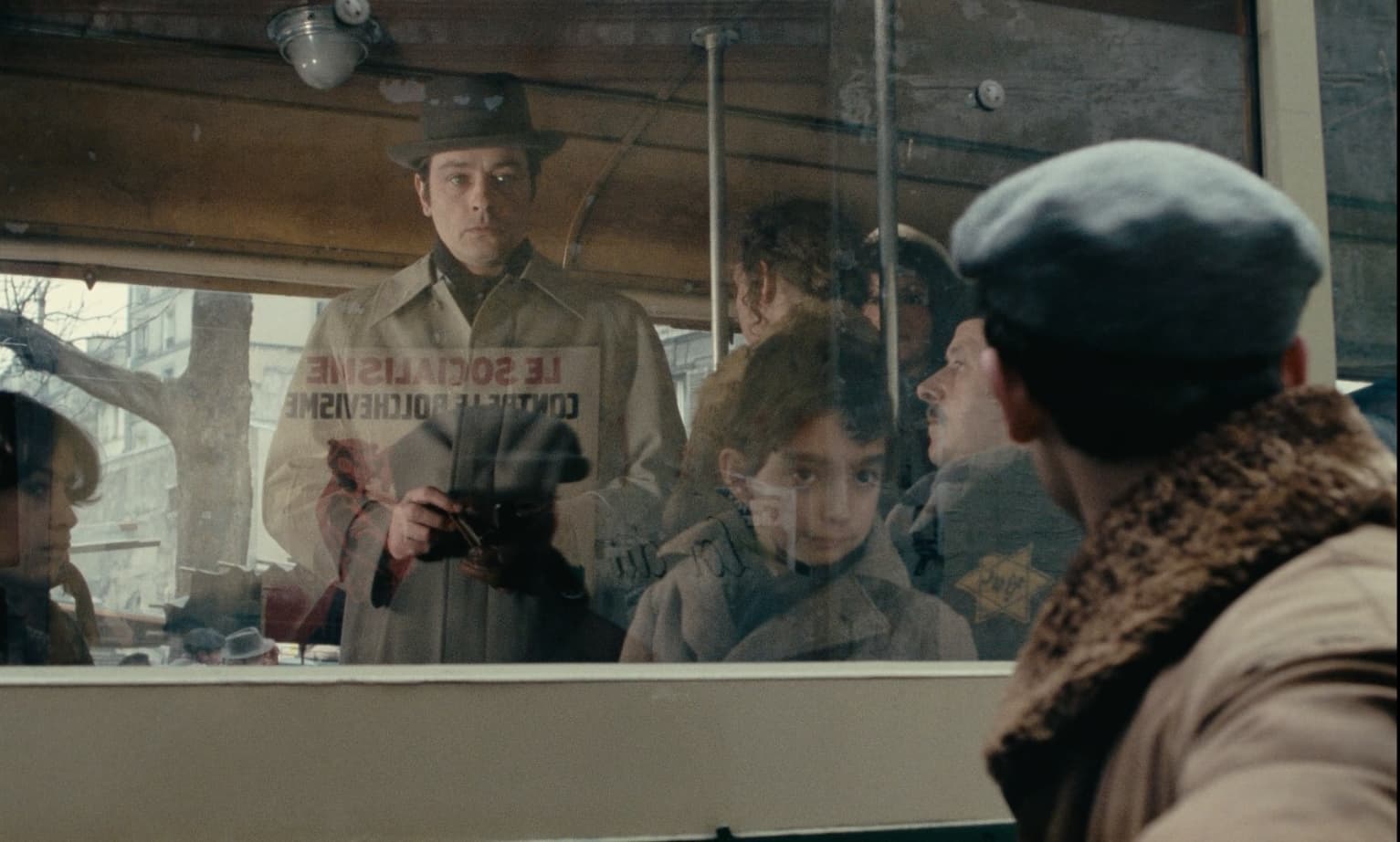
In Mr. Klein, the violence of the gaze of the Other – the dominant gaze of the collaborationist machine that lists, excludes and assigns an identity according to criteria that it has itself elaborated – is a trap from which the victim, in other words the one being looked at, cannot escape. It is within this trap that Klein struggles in the first part of the film. The more he insists on proving that there is another Klein, the more facts accumulate that prove the contrary. More precisely: he, and we with him, understand that it is impossible to prove his identity. But in the course of his research, he also discovers the nature of this opposite that he is tracking down and gradually succumbs to a form of seduction that has as much to do with the repressed (the buried Jewishness attested to by the embarrassment of the Strasbourg father), with guilt (the shame of remaining blind to the fate of the Jews), as with the adventure that embraces those who live in History (Klein’s supposed existence, both dangerous and romantic). This is why, if at the end of the film, Klein 1 continues to chase Klein 2, it is no longer with the aim of confounding a usurper and reasserting his original identity (Klein 1), but to put a face on the one he wants to become. This existential change explains, in part, the growing incomprehension of his friends, but also the change in Robert Klein’s mood and behavior during the course of the film, via Alain Delon’s brilliant interpretation, which allows the signs of this progressive epiphany to appear on his body and face. The sequence during which Klein’s apartment is emptied by the police and the administrator is divided into two parts and undoubtedly marks a first moment of rupture: Klein’s initially vehement protest is followed by a form of provocation when he encourages Nicole, Pierre’s wife, to play the first notes of a score recovered from Klein’s apartment on the piano. We then hear the beginning of the Internationale, a revolutionary song banned under Vichy, which provokes cries of rage from her husband and the commissioner, but gives Klein a feeling of enjoyment. For the first time, Klein opposes his own people head-on, behaves in accordance with what they think he is (a Jew and a subversive) and visibly derives a liberating satisfaction from it. This beginning of revolt against the society from which he comes belongs to the spirit of Klein 2 and will go as far as the disgust of his own, starting with Pierre, who concentrates in his person all the cowardice and opportunism of this civilized bourgeoisie that has accommodated itself to the worst. The subtle irony of the film is that the gaze of others, this “weapon pointed at me” (Sartre) by the forces of the bourgeoisie, is the most important factor. The forces of collaboration, their totalitarian injunction to prove one’s identity, gives rise, in Klein, to a being even more desirable than the one he clung to. As if he had finally turned the oppressor’s weapon around to transform it into an instrument of emancipation. Hence the serenity and unexpected vitality Klein shows in the very last part of the film, which contrasts with his corseted (civilized) ways at the beginning. Delon the samurai has become a free man in a hurry. On the station platform that is supposed to take him out of France, Klein has an appointment with Pierre. To the latter’s false seriousness (who has taken advantage of his friend’s misfortunes, now undesirable), Klein responds with an almost playful tone, suddenly refreshed, indifferent to his former civil identity (“So, no more Robert Klein!”) as well as to the new one that Pierre gives him (De Vigny), a liberation that he then expresses in hushed tones: “All things considered, I was fed up with present-day France; in this country we are too civilized, too polite and too much of a headache.” But who was Klein 1 a few months earlier if not a too polite and too civilized individual, in other words a collabo in a dull suit? Klein 1 has switched to the other France and his old habitus, which he now looks at from afar, since Klein 2, amuses him at the same time as it repels him.
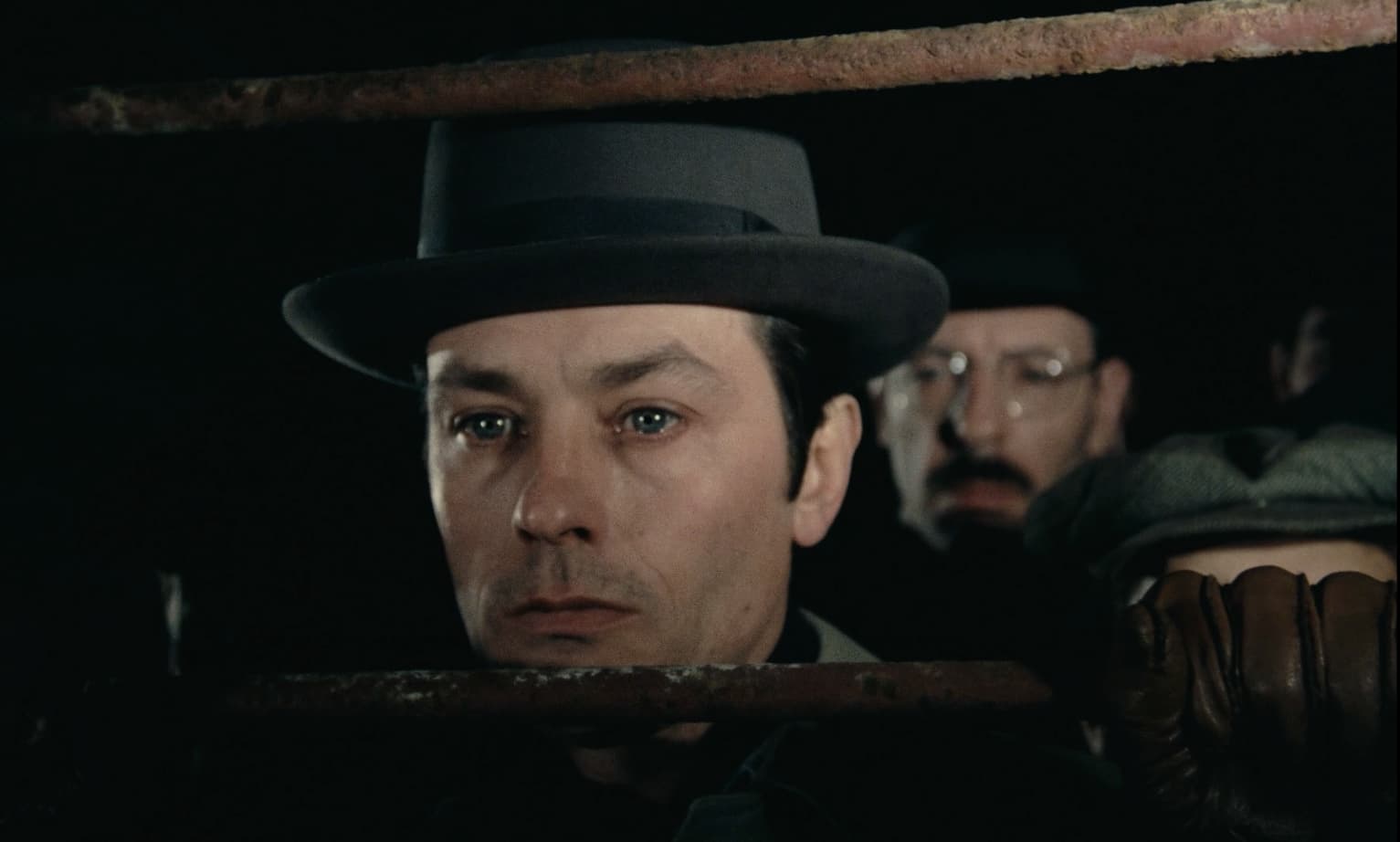
Locked up in this cattle train, Klein hurtles to his death, that is for sure, but he will die alive. In the last shot of the film, Losey then plays on the soundtrack the inaugural exchange between Klein and the Jewish salesman, a way of opposing the spectator’s total empathy for this new damned man with the memory that this same man, but in the skin of another, was also an ordinary bastard.
Jean-Baptiste Thoret
Jean-Baptiste Thoret is a film director (“We Blew It”, “Michael Cimino”), and author of some fifteen books on film history. His latest book, “Michael Mann, mirages du contemporain” (2021) has just been published in France by Flammarion.
